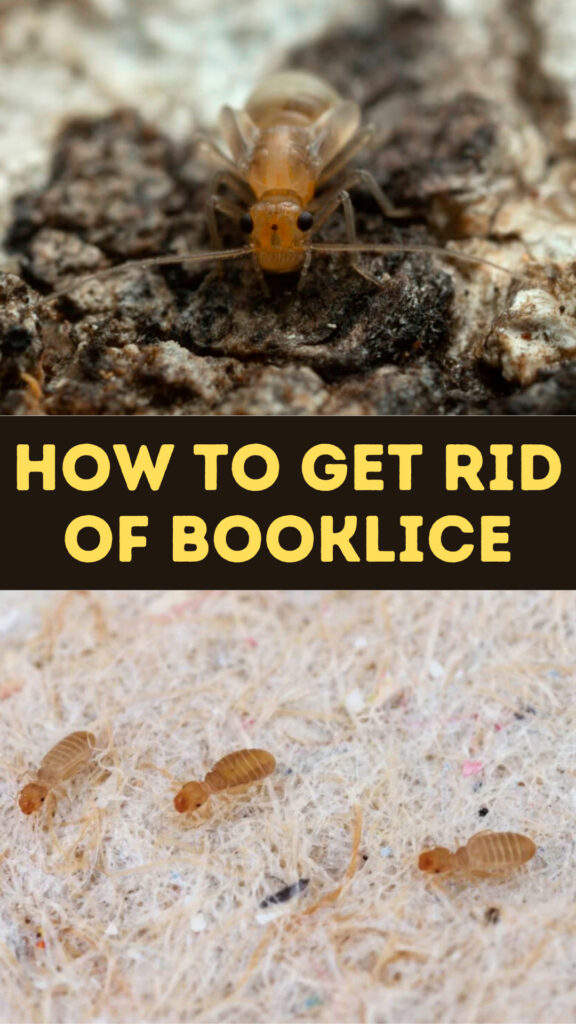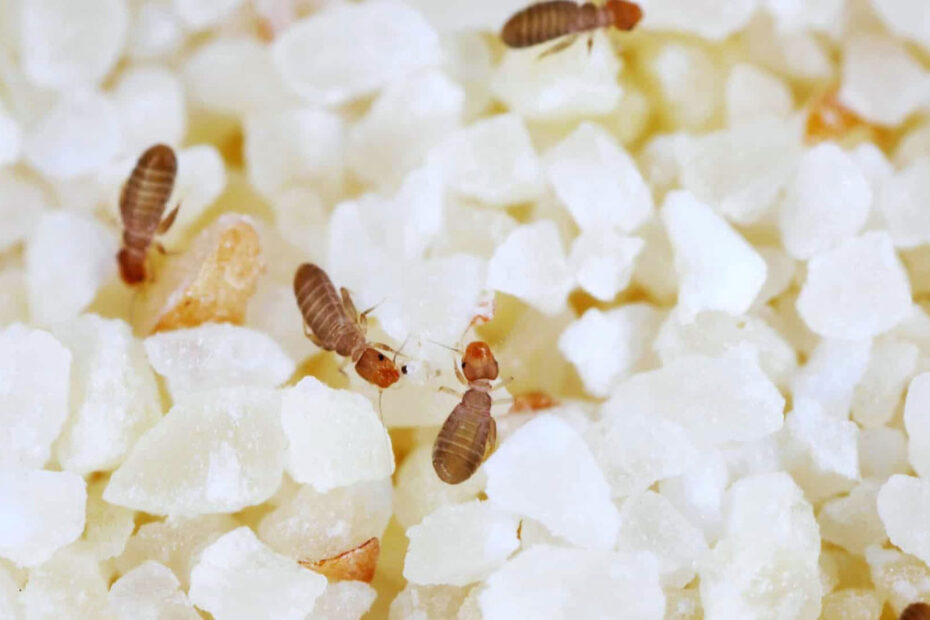You’ve just discovered tiny bugs crawling around your beloved books and papers, and it’s causing you stress. These pests, known as booklice, thrive in damp, moldy environments and can quickly become a nuisance. While they don’t bite or spread diseases, their presence can damage your valuable collections and create an unsightly mess.
Getting rid of booklice doesn’t have to be a challenging job. With the right approach, you can eliminate these pests and prevent them from returning. In this text, you’ll learn effective strategies to tackle booklice infestations and protect your treasured items from future invasions.
Key Takeaways
- Understand Booklice: Booklice, also known as psocids, are small, translucent insects that thrive in damp environments and feed on mold, posing a threat to books and paper.
- Common Signs of Infestation: Early detection includes observing tiny insects, damaged materials, and a persistent moldy smell in areas with high humidity.
- Causes of Infestation: Booklice flourish in environments with humidity levels above 60%, poor ventilation, and water leaks. They are commonly attracted to moldy books, improperly stored food, and wallpaper glue.
- Prevention Techniques: Key strategies include controlling humidity levels with dehumidifiers, ensuring proper ventilation, fixing leaks, and maintaining regular cleaning practices to eliminate mold and organic matter.
- Effective Removal Methods: Options for eliminating booklice include chemical treatments, natural remedies like reducing humidity and using essential oils, and, for severe infestations, professional pest control services.
- Long-Term Prevention Tips: Continual home maintenance and monitoring, such as using hygrometers to check humidity levels and storing books properly, help keep booklice at bay and protect valuable collections.

Understanding Booklice
Booklice, also known as psocids, are small insects that thrive in damp environments and feed on mold and mildew. Since they don’t bite or carry diseases, their primary risk lies in their potential to damage books and paper.
What Are Booklice?
Booklice are tiny insects usually measuring between 1 to 2 millimeters. They are translucent, with soft bodies and long antennae. While they don’t bite or spread infections, they feed on mold and organic matter, which makes books, wallpapers, and stored food susceptible to infestations where humidity is high.
Key Characteristics:
- Size: 1-2mm in length.
- Color: Translucent white or light grey.
- Environment: Humid and moldy areas.
Common Signs of Infestation
Detecting a booklice infestation early can help prevent significant damage to your collections. Look out for these common indicators:
Visible Insects:
- Tiny insects on books, shelves, or walls.
- Noticeable movement in damp, moldy areas.
Damaged Materials:
- Discoloration or mold patches on book pages.
- Tiny holes or frass (insect debris) around infested areas.
- Persistent, moldy smell surrounding the infested items.
You can confirm a booklice issue by observing these physical signs and characteristics. Keep an eye on high-humidity zones, typically where booklice thrive. Identifying these pests promptly will enable you to take necessary steps for infestation control.
Causes of Booklice Infestations
Booklice infestations originate from various factors related to environment and household conditions. These small pests thrive when given the right conditions, primarily involving moisture and food sources.
Environmental Factors
Booklice flourish in damp environments. High humidity levels, particularly above 60%, create ideal conditions. Such environments often result from poor ventilation or water leaks.
- Humidity: Levels above 60% are favorable for booklice.
- Ventilation: Poor airflow often causes increased moisture.
- Water Leaks: Leaky roofs or pipes contribute to dampness.
Common Household Attractants
Specific items in your home serve as attractants for booklice. These pests feed on mold and organic matter, which are commonly found on certain household items.
- Books and Paper: These materials absorb moisture and develop mold.
- Food Storage: Improperly stored grains and flours can attract booklice.
- Wallpaper: The glue used for wallpaper paste often harbors mold.
By addressing these environmental factors and household attractants, you can reduce the likelihood of a booklice infestation. Consistently maintain a dry, well-ventilated home to keep these pests at bay.
Prevention Techniques
Implementing prevention techniques is vital to keeping booklice at bay. You can ensure a pest-free environment by focusing on proper humidity control and effective cleaning practices.
Proper Humidity Control
Controlling humidity levels is crucial for preventing booklice infestations. These pests thrive in damp conditions, so maintaining a dry environment helps deter them.
Key Methods to Control Humidity:
- Use a Dehumidifier: Keep humidity levels below 50% with a dehumidifier, especially in book storage areas.
- Improve Ventilation: Ensure good air circulation by using exhaust fans and opening windows.
- Fix Leaks Promptly: Repair water leaks from pipes or roofs immediately to avoid creating moisture-rich environments.
- Store Items Properly: Keep books and papers in dry, well-ventilated areas. Use airtight containers for added protection.
Effective Cleaning Practices
Regular cleaning helps prevent booklice by eliminating the conditions they need to survive. Maintaining cleanliness in your home and storage areas is fundamental.
- Vacuum Regularly: Use a vacuum with a HEPA filter to clean floors and shelves where books are stored.
- Dust Frequently: Dust books and shelves with a microfiber cloth to remove mold spores and organic matter.
- Use Mold Inhibitors: Apply mold inhibitors to areas prone to dampness to reduce the likelihood of mold growth.
- Clean Spills Immediately: Wipe up liquid spills and thoroughly dry the area to prevent moisture accumulation.
Regular monitoring of humidity levels and consistent cleaning practices create an inhospitable environment for booklice, keeping your collections safe.
Methods to Get Rid of Booklice
Eliminating booklice requires a combination of techniques, including chemical treatments, natural remedies, and sometimes professional pest control services. By addressing the infestation from multiple angles, you can effectively manage and prevent further occurrences.
Chemical Treatments
Chemical treatments are often effective for severe infestations. Insecticides labeled for use against booklice are available in various forms, including sprays and powders. Here are steps to consider:
- Insecticidal Sprays: Apply sprays directly to affected areas, following the manufacturer’s instructions. Ensure proper ventilation during and after application.
- Powdered Insecticides: Dust powders into cracks, crevices, and other hard-to-reach spots where booklice may hide. Wear protective gear to avoid inhalation.
- Desiccants: Use desiccant powders like diatomaceous earth, which dehydrates and kills booklice. Scatter it lightly in problem areas but avoid direct contact with books and papers.
Always read and follow label directions when using any chemical treatments to ensure safety and effectiveness.
Natural Remedies
If you prefer non-chemical methods, several natural remedies can help reduce booklice populations. These methods are safer for use around children and pets:
- Lower Humidity: Maintain indoor humidity below 50% using a dehumidifier. Booklice thrive in high humidity, so reducing moisture can make the environment less hospitable.
- Sunlight Exposure: Place infested items in direct sunlight for several hours. Booklice are sensitive to light, and the heat can help kill them.
- Essential Oils: Use essential oils like tea tree, lavender, or peppermint. Mix several drops with water in a spray bottle and apply to affected areas. These oils deter booklice and have antimicrobial properties.
- Vacuuming and Cleaning: Regularly vacuum and clean infested areas. Dispose of the vacuum bag immediately to prevent re-infestation.
These remedies can help manage light to moderate infestations and work well as preventive measures.
Professional Pest Control Services
For extensive infestations or when other methods fail, professional pest control services may be necessary. Pest control experts have specialized tools and knowledge to handle severe booklice problems. When considering professional help:
- Inspection: Arrange for a thorough inspection to locate and assess the extent of the infestation.
- Treatment Plans: Work with professionals to develop a comprehensive treatment plan tailored to your home’s specific needs.
- Follow-Up Visits: Schedule follow-up visits to ensure the infestation is fully eradicated and to monitor for any signs of recurrence.
Utilizing professional services ensures a thorough approach and can provide peace of mind.
By combining these methods, you can effectively tackle booklice infestations and protect your valuable collections. Implementing preventive measures will help maintain a booklice-free environment.
Tips for Long-Term Booklice Prevention
To keep booklice at bay, take proactive and ongoing steps. These measures ensure your home remains an inhospitable environment for these pests.
Regular Home Maintenance
Consistently maintaining your home deters booklice infestations. Here are critical practices:
- Control Humidity: Use dehumidifiers to keep indoor humidity below 50%.
- Fix Leaks: Promptly repair water leaks in plumbing, roofing, and foundations.
- Improve Ventilation: Ensure proper airflow using exhaust fans, especially in bathrooms and kitchens.
- Clean Regularly: Vacuum with a HEPA filter, dust bookshelves, and remove any mold promptly.
- Store Properly: Keep books and important papers in dry, well-ventilated areas. Use airtight containers for items prone to mold.
Continuous Monitoring
Keeping an eye on potential problem areas helps you catch issues early:
- Check Humidity Levels: Regularly use hygrometers to monitor and adjust indoor humidity.
- Inspect Books and Papers: Look for signs of mold or insects in your collections.
- Mold Prevention: Apply mold inhibitors to susceptible areas and materials.
- Frequent Spot Checks: Inspect humid areas, such as basements and bathrooms, for early signs of infestation.
By integrating these practices into your routine, you can effectively prevent booklice from taking over your valuable collections and living spaces.
Conclusion
By understanding the habits and preferences of booklice, you can effectively safeguard your valuable collections. Implementing preventative measures like controlling humidity, improving ventilation, and maintaining cleanliness will create an inhospitable environment for these pests. Should an infestation occur, a combination of chemical treatments, natural remedies, and professional services can help you eradicate them. Regular monitoring and proactive home maintenance are key to ensuring booklice don’t return. With these strategies, you can protect your treasured items and enjoy a booklice-free home.
Frequently Asked Questions
What are booklice?
Booklice, also known as psocids, are tiny insects (1-2 mm) that infest books and papers, especially in damp and moldy environments. They thrive in high humidity and feed on mold and organic matter but do not bite or transmit diseases.
What attracts booklice to my home?
Booklice are attracted to high humidity levels, usually above 60%, and environments that offer mold and organic matter, such as books, paper, improperly stored food, and wallpaper.
How can I tell if I have a booklice infestation?
Common signs of a booklice infestation include visible insects, damaged materials, and a persistent moldy smell. Early detection is key to mitigating damage.
How do I prevent booklice infestations?
Prevent booklice by controlling humidity levels, improving ventilation, fixing leaks promptly, storing items in dry areas, and maintaining regular cleaning practices like vacuuming and dusting with a HEPA filter.
What are effective methods to eliminate booklice?
Methods to eliminate booklice include chemical treatments, natural remedies, and professional pest control services. For severe infestations, insecticides and desiccants like diatomaceous earth are effective, while lowering humidity and using essential oils can help manage light infestations.
Can booklice cause harm to my valuable collections?
Yes, booklice can damage books and papers by feeding on mold and organic matter. Although they do not bite or transmit diseases, they can ruin valuable collections if left untreated.
What household conditions contribute to booklice infestations?
High humidity above 60%, poor ventilation, and water leaks create ideal conditions for booklice. Ensuring a dry, well-ventilated home can reduce the likelihood of infestation.
Are there any natural remedies to deal with booklice?
Yes, natural remedies include lowering humidity, exposing infested items to sunlight, using essential oils, and regular cleaning. These methods are effective for managing light to moderate infestations.
When should I consider professional pest control services?
Consider professional pest control services for extensive infestations that cannot be managed with DIY methods. Professionals can provide thorough inspections and tailored treatment plans.
How can I ensure long-term prevention of booklice?
Long-term prevention involves regularly monitoring humidity levels, promptly fixing leaks, improving ventilation, maintaining cleanliness, and checking books and papers for signs of mold or insects. Regular maintenance and proactive measures are essential.
